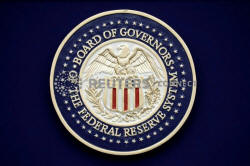Markets bet Fed is pushed to cut rates in coronavirus
response
 Send a link to a friend
Send a link to a friend
 [February 25, 2020] (Reuters)
- Financial markets on Monday ratcheted up
bets the U.S. Federal Reserve will be pressed to cut interest rates to
cushion a feared hit to economic growth from the spread of the
coronavirus, although one official cautioned against expecting the
central bank to over-react to short-term market moves. [February 25, 2020] (Reuters)
- Financial markets on Monday ratcheted up
bets the U.S. Federal Reserve will be pressed to cut interest rates to
cushion a feared hit to economic growth from the spread of the
coronavirus, although one official cautioned against expecting the
central bank to over-react to short-term market moves.
U.S. interest rate futures surged to their highest levels since last
fall as evidence the virus was spreading further outside its original
epicenter of China spurred a global sell-off in stocks and panicked
buying of government bonds.
Wall Street recorded its biggest sell-off in two years.
The federal funds futures contract tied to the Fed's July policy meeting
<FFN0> reflected a roughly 85% probability the central bank's benchmark
overnight lending rate would be at least a quarter percentage point
lower after that meeting's conclusion, according to the CME FedWatch
tool. A month ago that was seen as a roughly 50-50 prospect.
Contracts expiring in early 2021 <FFF1><FFG1> were priced for a Fed
policy rate of around 1% or lower, compared with the current level of
between 1.50% to 1.75%, where it sits after three rate cuts last year.

Top U.S. central bank officials have signaled repeatedly that they see
no need to cut rates further any time soon because they see the American
economy performing well and it is too soon to judge the risk from
coronavirus.
Cleveland Federal Reserve President Loretta Mester was the latest to
take note of the risk. In remarks to the National Association for
Business Economics conference in Washington, she described the outbreak
as a "big risk."
"At this point, it is difficult to assess the magnitude of the economic
effects, but this new source of uncertainty is something I will be
carefully monitoring," she said.
But Mester pushed back against the notion that the Fed would be driven
to act in response to jittery financial markets.
"I just caution that you don't want to over-react to volatility in the
markets if you're a monetary policymaker," she said.
Still, as the virus spreads, the resolve of Mester and other
policymakers is likely to be tested in the weeks ahead. Monday's stocks
swoon followed a sharp increase in the number of cases reported in
Italy, South Korea and Iran.
"The immediate risk is now about financial conditions," said Gregory
Daco, chief U.S. economist at Oxford Economics. "The real impact is
small ó but volatility, if the dollar rises, stocks fall, that is a
direct hit."
[to top of second column] |

The Federal Reserve seal is seen during Chairman Jerome Powell news
conference following the two-day meeting of the Federal Open Market
Committee (FOMC) meeting on interest rate policy in Washington,
U.S., January 29, 2020. REUTERS/Yuri Gripas/File Photo

In the U.S. Treasury market, the yield on the 30-year bond <US30YT=RR> - often
viewed as a proxy for growth expectations - tumbled to record low of around
1.81%.
Perhaps more tellingly for the Fed, the 2-year note's <US2YT=RR> yield slid to
below 1.25%, the lowest in nearly three years, taking it further below the Fed's
rate. As the shortest duration of so-called coupon debt - bonds with a maturity
longer than a year - the 2-year note's yield reflects bond market investors'
expectations for Fed policy.
A month ago it was generally aligned with the fed funds rate. As concerns about
the coronavirus have grown, however, the gap between the two has widened at
roughly the pace seen last spring before the Fed's run of three rate cuts
between July and October.
On Friday, a survey of U.S. purchasing managers indicated that activity in both
the services and manufacturing sectors appeared to have stalled this month
because of the outbreak, which upended global supply networks when goods
production in China ground to a halt.
Apart from that report from IHS Markit, little evidence has yet to emerge of the
virus denting U.S. growth, although economists have begun predicting it will.
Goldman Sachs on Sunday cut its estimate for first-quarter gross domestic
product growth to 1.2% from 1.4% because of the disruption to supply chains.
At NatWest Markets, analysts said they "agree that this Fed has a very dovish
reaction function," and thus would not be surprised by a Fed response before too
long. But they question whether it will actually help much in the event the
outbreak begins affecting U.S. businesses.
"If a U.S. company (with a certain earnings stream priced in) canít source
inputs because overseas factories are idled with workers sick or locked down in
their homes, a fed funds rate at 1.5% or at 0.25% is irrelevant," they wrote in
a note to clients on Monday.
(Reporting By Dan Burns; Additional reporting by Lindsay Dunsmuir and Howard
Schneider in Washington; Editing by Alex Richardson and Dan Grebler)
[© 2020 Thomson Reuters. All rights
reserved.] Copyright 2020 Reuters. All rights reserved. This material may not be published,
broadcast, rewritten or redistributed.
Thompson Reuters is solely responsible for this content. |